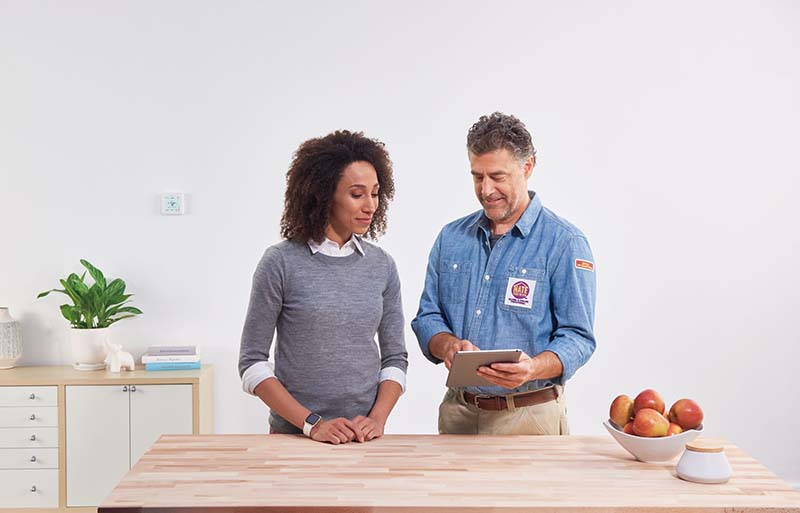Thermostats are a great example of how the most intelligent HVAC products are only as smart as the end-user. But it’s really more about being informed. Manufacturers are producing devices that do more and provide more feedback than ever before. It’s the contractor’s job to ensure consumers understand the functionality of smart thermostats without becoming overwhelmed by the features and data.
Doing so creates happier customers. Leaving them to figure out the devices on their own creates customers who are frustrated with the contractor and the manufacturer. Avoiding this situation requires HVAC contractors to understand the devices themselves and share this knowledge with staff.
“Contractors who are knowledgeable about the latest technologies and features will set themselves apart,” said Ed Blittschau, vice president of Marketing & Business Development at Emerson. “Understanding the various features of smart HVAC and being able to apply those benefits to customers’ needs is fundamental in bringing value to the product. Sharing added benefits of smart HVAC products outside of what’s already known not only adds value to the product but can help build trust between contractors and their customers.”
Blittschau gives the example of energy efficiency. By some estimates, HVAC accounts for half of a homeowner’s total energy bill. A smart thermostat can cut those costs by nearly 25%, if used correctly. But if consumers expect those savings and they fail to appear, they become dissatisfied.
Two Visits to Get Full Effect
That’s why Sam Troyer, president of Comfort Zone Inc. in Cape Coral, Florida, always schedules a follow-up visit after his techs install a smart thermostat.
“We have the installer show the homeowner how to do the basic functions,” Troyer said. “Then we set up a follow-up to show them all the features and benefits. It’s an opportunity to make sure the client is satisfied with the system overall.”

(Courtesy of Resideo)
The follow-up visit takes the tech through a checklist to make sure the homeowner knows how to perform tasks such as setting the humidity level. The tech also makes sure the device is hooked up to the house’s Wi-Fi.
Dave Quam, global connected services director at Resideo, said most smart thermostats are sold as part of what is already a high-dollar investment for homeowners. That is why HVAC contractors need to explain the crucial role these devices play in getting the most return on the investment for consumers.
“Since the thermostat is the main control of that appliance, it's crucial to speak to how the two really work together,” Quam said. “From zoning to running the fan, there are many things the thermostat can control, and it's important for the contractor to help the homeowner connect the dots.”
Consumers Worry about Privacy, Frustrated by Failures
This requires training for technicians. Both Emerson and Resideo offer plenty of training opportunities for contractors. Emerson offers free online training valuable to technicians, contractors, wholesalers, end users, and original equipment manufacturers. Resideo set a record in 2020 for the training hours it provided. This training makes techs better able to educate consumers and address their concerns.
One of the biggest challenges for HVAC contractors to overcome with smart thermostats is a hesitance to adapt new technology. Some find it unnecessary, while others worry about privacy.
To address privacy concerns, Troyer explains any data sharing requires the homeowners to opt in. There are many good reasons for the consumer to do so. Sharing information with the contractor improves maintenance, sometimes heading off problems before they grow. If a problem does develop, data can help a contractor arrive at the job with the right parts.
Blittschau said there are also benefits for consumers who share data with local utilities. These companies often have a fixed energy supply and are increasingly seeking ways to accommodate peak demand times, particularly in the heat of summer, and avoid having to take drastic measures to keep up with customer demands. Through demand response programs, customers are offered incentives to provide utility companies with access to adjust temperature remotely and in turn control the increased demand and avoid too high of a peak.
Troyer explains to consumers that access is limited. For example, a contractor can see how many amps a compressor is pulling or how cold the air is coming out of an air handler. A contractor cannot change the temperature or alter the program.
Awareness of Devices Brings Challenges
The other challenge for HVAC contractors is the opposite of warry customers — overenthusiastic consumers who want the latest gadget. Troyer’s firm only handles thermostats in which he has confidence. But consumers often buy smart thermostats online or at a big box store and then want HVAC contractors to install them.
Troyer said his technicians install these units and make sure they function. That’s the end of their service. They won’t program these thermostats or connect them to any other devices. That’s left to the homeowner. There is also no warranty that comes with the service.
“There’s too many brands and that would require us having to learn the intricacies of every single brand that’s out there,” Troyer said.
Either through these aftermarket units or manufacturer-supplied thermostats, Troyer said many consumers have been burned and pushback against them. Troyer said the biggest issues are firmware updates and units that continuously drop off the Wi-Fi. Quam said smart thermostats need to work for everyone.
“It has to be simple, intuitive, and offer the best benefit to the pro and homeowner,” he said. “For most that means fast installation, safe, and secure cloud data transfer and a reliable product that helps them save money on heating and cooling costs.”
Troyer agrees with Blittschau and Quam that smart thermostats now play a crucial role in the HVAC system. They adapt better to the home environment, creating a better experience than thermostats that are set just once.
“If you want the highest level of comfort and efficiency, it’s at the point where you’re going to have to have a smart thermostat,” he said.








